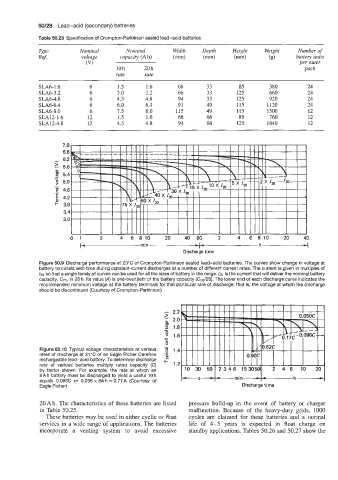Page 544 - Battery Reference Book
P. 544
50/28 Lead-acid (secondary) batteries
Table 50.23 Specification of Crompton-Parkinson sealed lead-acid batteries
Type Nominal Nominal Width Depth Height Weight Number of
Re$ voltage capacity (Ah) (-1 (mm) (mm) (g) batter); units
(V) per outer
10h 20h pack
rate rate
SLA6-1.6 6 1.5 1.6 66 33 85 380 24
SLA6-3.2 6 3.0 3.2 66 33 125 660 24
SLA6-4.8 6 4.5 4.8 94 33 125 920 24
SLA6-6.4 6 6.0 6.4 91 49 115 1120 24
SLA6-8.0 6 1.5 8.0 115 49 115 1500 12
SLA12-1.6 12 1.5 1.6 66 66 85 160 12
SLA 12-4.8 12 4.5 4.8 94 66 125 1840 12
w m i n I:
Discharge time
Figure 50.9 Discharge performance at 20°C of Crompton-Parkinson sealed lead-acid batteries. The curves show change in voltage at
battery terminals with time during constant-current discharges at a number of different current rates. The current is given in multiples of
I20 so that a single family of curves can be used for all the sizes of battery in the range. I20 is the current that will deliver the nominal battery
capacity, CZO, in 20 h. Its value (A) is one-twentieth of the battery capacity (C20/20). The lower end of each discharge curve indicates the
recommended minimum voltage at the battery terminals for that particular rate of discharge; that is, the voltage at which the discharge
should be discontinued (Courtesy of Crompton-Parkinson)
-
- 2.2
>
o, 2.0
m
S
- 1.8
- 1.6
-
m
0
Figure 50.10 Typical voltage characteristics at various 1.4
rates of discharge at 21°C of an Eagle Picher Carefree 'E
rechargeable lead-acid battery. To determine discharge ,?'
rate of various batteries multiply rated capacity (C) 1.2
by factor shown. For example, the rate at which an
8A h battery must be discharged to yield a useful 10 h
equals 0.096C or 0.096 x 8Ah = 0.77A (Courtesy of h-
Eagle Picher) Discharge time
20Ah. The characteristics of these batteries are listed pressure build-up in the event of battery or charger
in Table 50.25. malfunction. Because of the heavy-duty grids, 1000
These batteries may be used in either cyclic or float cycles are claimed for these batteries and a normal
services in a wide range of applications. The batteries life of 4-5 years is expected in float charge on
incorporate a venting system to avoid excessive standby applications. Tables 50.26 and 50.27 show the

